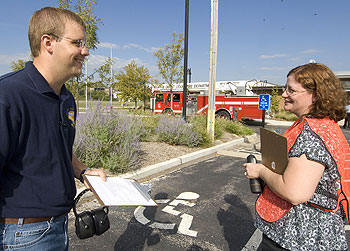Last March, food left unattended while cooking started a fire in a first-floor residence of Millbrook Apartments. Fortunately, no one was hurt, but the blaze temporarily displaced 51 students and cost the University just under $174,000 in damages.
Millbrook’s was just one of five serious fires on University property in the past three years. In an effort to prevent No. 6, the University is recognizing this week, Oct. 7-13, as National Fire Prevention Week and is working to educate students, faculty and staff on how to prevent and what to do in case of a fire.

“We had celebrated National Fire Prevention Week in the past,” said Mark Bagby, University disaster coordinator, “and I pushed to revive it to be sure faculty, staff and students are cautious and will know where to go after evacuating a building.”
Since 2000, there have been 113 campus-related fire fatalities in the United States, according to Campus Firewatch, a monthly newsletter that focuses on campus fire safety; 20 occurred in the 2006-07 academic year. The more educated and aware students, faculty and staff are of how to prevent fires and handle emergency situations, the better, Bagby said.
During National Fire Prevention Week, the Environmental Health and Safety Department is focusing on educating the University community about exit routes and emergency assembly points.
Bagby and his staff are working with area fire departments, the Washington University Police Department and others to establish emergency assembly points for every building on campus.
The project will be completed by the end of the month, and emergency assembly points for all campus buildings will be listed at ehs.wustl.edu.
|
Using a fire extinguisher
Even the most petite adults are capable of using the fire extinguishers placed in campus buildings, said Mark Bagby, University disaster coordinator. They just need to remember the acronym “PASS”:
|
Of the 113 fatalities since 2000, 81 percent occurred in off-campus housing, which is why it is important for those living off-campus to plan for an emergency.
Bagby recommended establishing a place away from your home — on a sidewalk, at the neighbor’s house — where housemates or family can congregate.
Bagby also advised each department to designate a fire coordinator to teach employees correct evacuation routes and assembly points and, in an emergency situation, to perform a head count after evacuating to make sure everyone on staff is accounted for. In residence halls, this duty is performed by RAs and RCDs.
When evacuating, briefly pause to close doors behind you. That simple act can help slow or stop the spread of smoke and fire, Bagby said.
The Environmental Health and Safety Department works throughout the year to ensure the campus is prepared for emergency situations. Workers perform annual and monthly fire safety checks of all campus buildings to make sure emergency equipment such as sprinkler heads, horns and strobes are functioning correctly.
They also check that no furniture or equipment is blocking fire escape routes and no mounds of paper clutter — a fire hazard — are accumulating in rooms or hallways.
The department also organizes fire drills of all dorms and fraternity buildings. In the past, fire drills were annual, but students, be warned: Starting in January, they will come once a semester because of a change in the fire code.
Don’t be too upset about having your morning, afternoon or evening interrupted — remember, the University is looking out for your safety.
|
Six fire safety tips
1. Don’t tamper with your smoke detectors. “Students sometimes want to smoke in their rooms or use candles and incense, so they will put a baggie or tape over the smoke alarm, or find a way to disable it that doesn’t show in our computers that it’s not working,” said Mark Bagby, University disaster coordinator. 2. Replace batteries. Most off-campus housing and faculty/staff homes use battery-powered smoke detectors. To make sure the detectors are ready in case of an emergency, residents should test smoke detectors monthly and replace the batteries every six months — when clocks are changed for daylight savings time. 3. Don’t light candles or cigarettes or burn incense in your room or office. It’s not allowed in classrooms, offices or in University housing managed by Residential and Greek Life. 4. Don’t overload your electric socket. Students bring big-screen TVs, toaster ovens, stereos, hotplates and other electronic equipment to school — often more gadgets than there are sockets in their dorms or apartments. Many people use power strips and overload their rated capacity, which can lead to problems. “The circuits aren’t designed for such loads,” Bagby said, “and overloading the system can lead to electrical fires.” 5. Clean up after yourself. If combustibles (paper towels, clothes or cardboard) pile up, a spark from a cigarette or an overloaded appliance could ignite your clutter. Leaving piles of trash around also helps fires to spread quickly. 6. Be aware. Even a small amount of alcohol can slow reaction times and cause people to fail to hear sounds they normally would notice. “Under normal circumstances, a fire alarm needs to be 75 decibels for enough people to hear it,” Bagby said. “One study showed that even having a couple drinks, where your blood alcohol content is .075, a much louder sound — 95 decibels — is needed to respond to a fire alarm.”
|